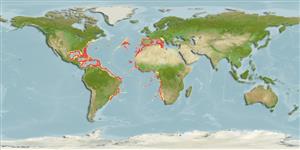Actinopterygii (ray-finned fishes) >
Anguilliformes (Eels and morays) >
Nettastomatidae (Duckbill eels)
Etymology: Nettastoma: Greek, netta = duck + Greek, stoma = mouth (Ref. 45335); melanurum: From the Greek melan meaning black, dark, and oura meaning tail, referring presumably to the dark edges of the posterior part of the dorsal and anal fins.
Environment / Climate / Range
Ecology
Marine; bathypelagic; depth range 37 - 1647 m (Ref. 4454), usually 329 - 860 m (Ref. 47377). Deep-water, preferred ?; 45°N - 30°S, 98°W - 17°E
Eastern Atlantic: Portugal to the Gulf of Guinea including western Mediterranean. Western Atlantic: Gulf of Mexico to the Guianas and to southern Brazil (Ref. 47377).
Length at first maturity / Size / Weight / Age
Maturity: Lm 53.5, range 42 - 68.2 cm
Max length : 79.8 cm TL male/unsexed; (Ref. 96016); max. published weight: 255.50 g (Ref. 96016)
Short description
Morphology | Morphometrics
Vertebrae: 190 - 210. Usually five supratemporal pores, SO5 absent. Lateral line pores 43-49. Median vomerine teeth somewhat enlarged. Posterior nostril near anterodorsal margin of eye.
Occurs in holes on muddy bottoms of continental slope. Feeds mainly on crustaceans (Ref. 4776).
Smith, D.G., 1990. Nettastomatidae. p. 172-175. In J.C. Quero, J.C. Hureau, C. Karrer, A. Post and L. Saldanha (eds.) Check-list of the fishes of the eastern tropical Atlantic (CLOFETA). JNICT, Lisbon; SEI; Paris; and UNESCO, Paris. Vol. 1. (Ref. 4454)
IUCN Red List Status (Ref. 115185)
CITES (Ref. 94142)
Not Evaluated
Threat to humans
Harmless
Human uses
Fisheries: of no interest
More information
ReferencesAquacultureAquaculture profileStrainsGeneticsAllele frequenciesHeritabilityDiseasesProcessingMass conversion
Tools
Special reports
Download XML
Internet sources
